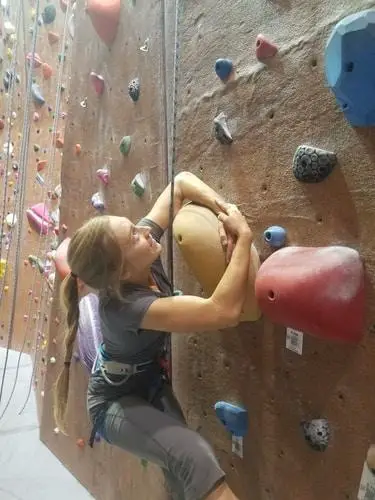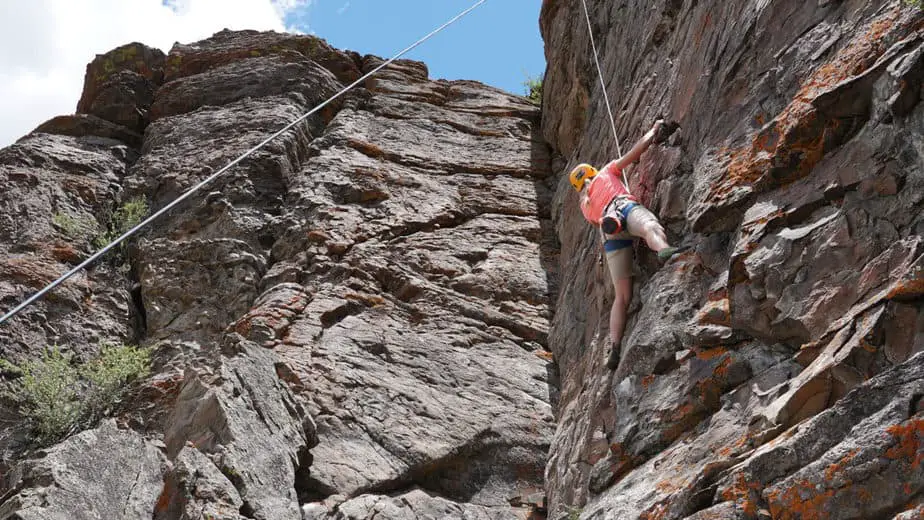We’re all competitive, even when we try not to be. It’s natural to want to know how you stack up to other climbers. There are a lot of nuances that go into climbing grades, even though they’re supposed to be translatable between crags and gyms.
Climbing a 5.10 is a solid intermediate step that puts any climber in good company. It requires above average fitness and an understanding of basic techniques. Up to a 5.8 is considered beginner, 5.9-5.10d is intermediate, 5.11 to 5.12d is hard, and 5.13+ is elite.
Just because you can get up a 5.10 in the gym on top rope doesn’t necessarily mean you can lead 5.10 routes outside. There are lots of variables that can affect your climbing ability, including the type of route, style of climbing, and heck- even the weather!
What is A Good Climbing Grade?
Of course, the answer is that “It Depends.” It depends on your build and body composition, the amount of time you dedicate to climbing and training, and honestly, even the people you climb with.
I remember the day that I looked up Alex Honnold and Tommy Caldwell’s heights and weights only to find out that they don’t really have any advantage over me. I can’t blame my lack of success on my height like I do when I play basketball! Side note- almost 20 %
% of 7-footers play in the NBA!
of 7-footers play in the NBA!
While being within a certain height and weight window helps (a long wingspan wouldn’t hurt), strength, endurance, and technique are far more important. With enough training, just about anyone can get up to the advanced range of a 5.12.
If you’re climbing 2-3 days per week, you should probably be able to beat the kid that shows up for a birthday party at the gym. If you’re starting out though, don’t beat yourself up! The only person you really need to compete with is yourself. Get better every time you go.
Maybe you have your eyes on the East Buttress of El Capitan or the Casual Route on The Diamond. Or, maybe you simply just want to climb that bolted, local 5.10 choss nugget that you’ve walked by on the trail.
First of all, pat yourself on the back. You’ve invested in learning and you’ve climbed a 5.10! Now, consider that like many things in life, climbing grades are all about perspective. 5.10 can mean a lot of things!

Climbing Grade Mastery
Sending that 5.10 in your local gym feels great, and it is a stepping stone to be sure. However, it is vastly different from possessing the capability to onsight any 5.10, anywhere, regardless of style. Just because you have done it doesn’t mean you can do it outside, on lead, or in a crack.
There are a lot of variables that go into what your experience is going to be like on a 5.10, and what that accomplishment means in the bigger picture.
To me, you’re a 5.10 climber if you’re willing to lead 5.10’s outside and risk having to leave gear behind if you can’t complete it. Others say that you have to be able to lead any single 5.10, and others say you can only claim the grade if you can climb all of them.
This is the difference between a rudimentary understanding of movement and rope systems and a level of mastery that is attainable but takes years of experience- logging literal vertical miles on the stone. Arguably, many climbers never actually reach this level of mastery.
Let’s break it down and get some perspective. This will help you navigate the already nebulous and subjective task of deciphering climbing grades.
What Do Climbing Grades Even Mean?
Across the world, many different rating systems have evolved. In the United States, we use the Yosemite Decimal System or YDS. The Yosemite Decimal System evolved as climbers set off on big walls.
They slowly adopted free climbing, as they tried to rely less on artificial aid. Free climbing also was ‘clean’ and greatly reduced the impact that the climbers had on the rock itself.
If you go to Yosemite, 5.10 will not feel like the blue route in the corner of your local rock gym. 5.10 in Yosemite doesn’t even mean the same thing across various styles of climbs!
For instance, a 5.10 slab or offwidth, or even a 5.10 pitch up high on El Capitan, will feel vastly more difficult to most climbers than a 5.10 at Cookie Cliff or The Church Bowl.
This is to say that you can expect this discrepancy across the globe. Climbing grades have different meanings depending on who established the route, what year it was done, what style it was done in (trad, sport, alpine, bigwall), what kind of rock it is, etc.
Climbing grades are a general guideline of what to expect, but that also depends on the context of the route. Heck, even gyms across the country don’t have a standard benchmark for climbing grades.
Remember that 5.10 didn’t even exist 50 years ago! People were climbing that hard, but 5.8 and 5.9 were as high as the scale went at that time. This is often why you’ll hear old routes referred to as ‘sandbags’, or misleading and under-graded.
Quick Explanation of Climbing Grades
Listed below are basic outlines that can help give you an idea for what that particular grade means. Learning the other subtleties and nuances, or understanding the context of a grade in a particular climbing venue, are left to experience.
- 1st Class – Simple hiking on flat terrain.
- 2nd Class – This is hiking on more angled terrain, expert trails with vertical gain, etc.
- 3rd Class – Climbing kind of starts. This is steeper and occasionally will require the use of your hands for progress. 3rd class also involves more exposure. Most people consider 3rd and 4th Class climbing ‘scrambling’, where a rope is generally not needed, but the consequence of a fall is the same as free-soloing.
- 4th Class – This is similar to 3rd Class, but with more exposure (a potentially deadly unroped fall) and more use of your hands for upwards progress. Many people will still want a rope for 4th Class terrain.
- 5th Class – This is where ‘real’ or modern climbing truly begins and a rope is mandatory for most people. From here, the grades are further broken down and categorized by the YDS.
The YDS begins at 5.0 and goes all the way to 5.15d currently. At 5.7, plus and minus grades are introduced and at 5.10 the difficulty ratings are segmented even further into letter grades.
Each of these grades is theoretically the same jump in difficulty between one to the next. For example, going from a 5.9+ to a 5.10a would be the equivalent jump from 5.10c to 5.10d.
Below is the progression of fifth class climbing grades:
- 5.0 to 5.6
- 5.7- to 5.9+
- 5.10a, 5.10b, 5.10c, 5.10d, 5.11a, etc.
As you can see, if you’ve made it to 5.10, you’ve progressed through quite a few grades. Many people on the planet never experience anything past 2nd class, so that’s a cool thing too. Having gratitude for coming this far will help you focus on personal growth and maintaining the stoke to see your next goal through.
Safety Ratings
It is also worth mentioning that climbing grades can be further categorized by their safety ratings. Generally, a climb that is just 5.10 will be considered a relatively safe climb for someone who is climbing within their limits (although all climbing has inherent risk associated with it).
However, you may have noticed that some routes receive a PG, PG-13, R, or X rating. These ratings give the would-be climber some degree of warning about the route.
A PG or PG-13 route may have spots where a fall could be odd or potentially dangerous. An R rated route may have spots where a fall will result in serious injury, and an X rated route would have a fall that could result in death.
It’s important to be aware of these warnings and make good decisions based on experience.

Indoor Versus Outdoor Climbing Grades
Outdoor vs indoor grades are also quite different. Many gyms will be relatively ‘soft’ with their climbing grades. This makes sense from a business standpoint – you want people to be able to get up routes and feel a sense of accomplishment.
Grades are usually consistent within a single gym, but routesetters at one gym are different from those at another gym. The same can be said at crags in different regions- while grades can be changed over time, they usually remain at what the first climbers rated them.
However, it’s very important to recognize that climbing a gym grade in no way translates to climbing the same grade outside. Much more thought and skill goes into an equivalent send outside. For example, climbing outdoors you can’t just look for the purple-colored rocks.
So How Hard is A 5.10 Then?
Now that we’ve discussed a few ideas, we can say that 5.10 is the hinge-point into truly difficult and technical climbing. Often, climbers can become very confident on 5.10 and even 5.11 without much training though- it just takes desire, time, and experience.
A brand new climber who is in excellent physical shape can usually climb 5.10’s in the gym, but will struggle outdoors or on lead.
Once you reach 5.12, that’s where training may be required to free climb the grade and continue to progress. It’s no longer enough to rely on technique alone, nor great upper body strength. Climbers in this range have to train hand and finger strength and learn difficult techniques.
A good example of the idea that 5.10 is the beginning of truly hard climbing is found in bouldering. Bouldering starts at 5.10 essentially.
When we look at the V-Scale (Vermin Scale) that rates boulder problems in terms of a progression of difficulty similar to the YDS, a V0 (the bottom of the scale) roughly should encompass all grades below about 5.10b. V1 would be similar to crux moves on a 5.10+, V2 would be 5.11a/b, V3 5.11c/d, and so on.
One way to sharpen your free climbing skills is to go bouldering! I highly recommend this approach if you really want to improve your climbing movement and strength in a fun way.
The Path to 5.11
It takes a considerable amount of experience to get onto big routes and even local choss that you’re just starting to cut your teeth on. A bit of self-examination is an important piece of your safety equipment while climbing. Climbing within, or knowing how to push outside of, your limits are important to a long and happy career.
Many gym climbers and top ropers can easily climb the moves on a 5.10, but to be able to competently lead 5.10 is something else. Depending on your aspirations, it’s good to understand some path, or progression, that can safely take you forward and expand your climbing abilities.
You may be saying to yourself, “Is a 5.10 even that difficult? Or is it pretty good? Am I a good climber now that I did one?!”
When you can answer these questions with your own opinions, you will have a much deeper understanding of the answers, hopefully. Let’s assume you are seeking some answers or mentorship now, though.
Tips For Advancing to the Next Level
Okay, now let’s tie this all together. You’ve sent your first 5.10, maybe in the gym, maybe it was a sport lead, or maybe it was a top rope. Now you’re hungry for more. So what are the next steps?
I’ll describe two paths forward that you should take simultaneously, one that will help improve your free climbing ability and comfort on the rock, and one that will also increase your margins of safety and make you a better partner.

Fitness & Training
First, you’ll want to consider your climbing progression through the grades as a pyramid. Granted, some people can skip steps and climb incredibly hard routes very quickly after beginning to climb. For everyone else, the pyramid approach is the best way to help you master movement and build fitness. You can think of it this way-
At the base of the pyramid are a lot of routes that are easy to you (if you have climbed 5.10, let’s call these routes 5.7). You’ll want to climb a ton of 5.7s to build your base up.
Then, climb a lot of 5.8s and 5.9s. Then, the 5.10s should start feeling more attainable and you can start building on that progression. You’ll want to climb a lot of 5.10a’s before you hope on a 5.10b, and so on.
Safety & Technique
Lastly, now that you’re climbing more difficult routes, it’s very important to take an active role in your safety. It is encouraged to take classes, seek more information such as this blog, and find a mentor whom you can trust.
Many climbers skip this part of the progression, but they are cheating themselves when they do this. Experience is tantamount to climbing safely, so having someone who can help guide your progression is absolutely priceless.
Mentors can also teach you important ethical principles, such as Leave No Trace, and general climbing etiquette. Knowing your rope systems and being able to self-rescue is critical, and the only way you can learn that is to find the information and practice with someone who knows what they’re doing.
Conclusion
To wrap it all up, climbing 5.10 is a great benchmark and you should be proud of reaching that, no matter the style that you’ve done it in. Climbing is a life long pursuit and only gets more satisfying the more you do it. It should be clear now that climbing 5.10 can mean different things, but it’s a sign that you’ve invested some blood, sweat, and tears into climbing.
Ultimately, that’s what it takes to keep improving and it’s also why we keep coming back for more – because it isn’t easy! Before you know it, you’ll be climbing 11a and you will probably have a few more questions after that. So come on back to The Rockulus when you’re ready for more answers.
Related Questions:
Is Climbing a 5.11 Good? A 5.11 climbing grade is the first real step into difficult climbing, and requires both training on both physical strength and good technique. While climbing at lower grades can be done by beginners in good shape, this is the hinge point that separates intermediate from advanced climbers.
How Hard is a 5.8 Climb? The climbing grade 5.8 is typically known as the easiest intermediate-rated route for outdoor climbing. For climbing indoors, generally beginners in good shape can complete a 5.8. If you can do a pull up, you can probably do a 5.8 climb.
How Long Does it Take to Get Good at Climbing? It usually takes 5-10 climbing days for a climber in good physical shape to advance to the intermediate level of 5.8-5.10. Mastery of these routes, including lead climbing outdoors, can take several months with consistent climbing.


